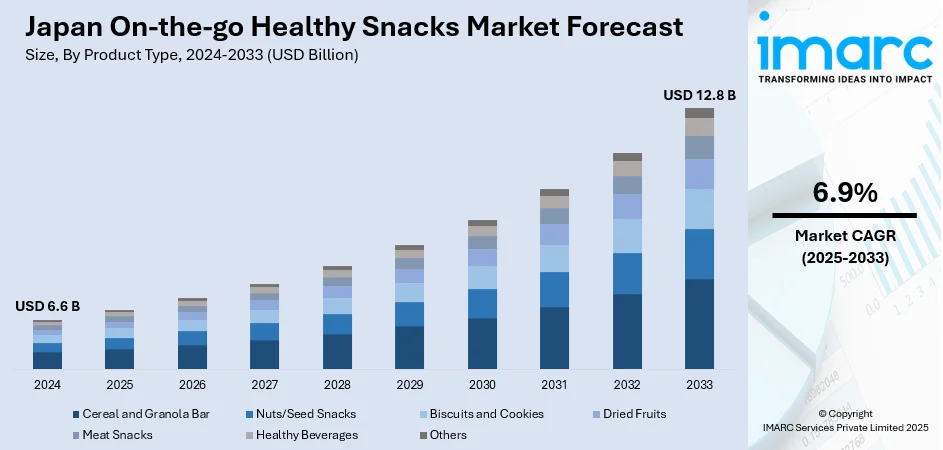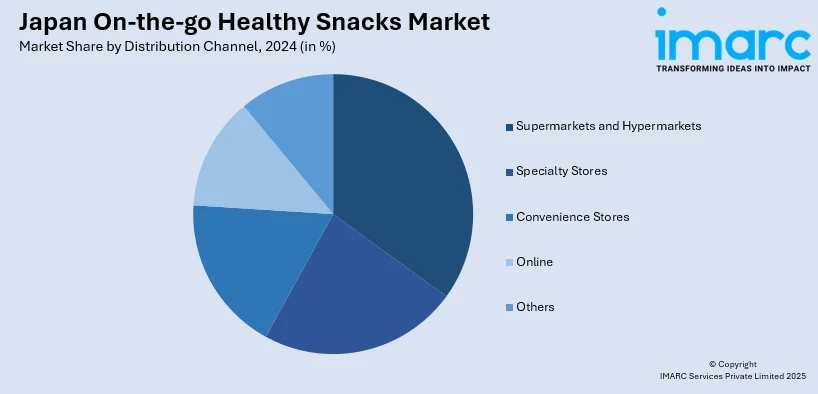
Japan On-the-go Healthy Snacks Market Size, Share, Trends and Forecast by Product Type, Nutritional Content, Packaging Type, Distribution Channel, and Region, 2025-2033
Japan On-the-go Healthy Snacks Market Overview:
The Japan on-the-go healthy snacks market size reached USD 6.6 Billion in 2024. Looking forward, IMARC Group expects the market to reach USD 12.8 Billion by 2033, exhibiting a growth rate (CAGR) of 6.9% during 2025-2033. The market is experiencing significant growth mainly driven by rising demand for functional, clean-label, and portion-controlled options. Moreover, busy urban lifestyles, aging demographics, and preference for traditional ingredients are driving innovation, supporting steady market growth across retail and convenience channels.
|
Report Attribute
|
Key Statistics
|
|---|---|
|
Base Year
|
2024 |
|
Forecast Years
|
2025-2033
|
|
Historical Years
|
2019-2024
|
| Market Size in 2024 | USD 6.6 Billion |
| Market Forecast in 2033 | USD 12.8 Billion |
| Market Growth Rate 2025-2033 | 6.9% |
Japan On-the-go Healthy Snacks Market Trends:
Growing Focus on Functional Nutrition
Functional nutrition is becoming a key focus among Japanese consumers, especially in the snacking segment. This shift is contributing significantly to Japan on-the-go healthy snacks market share, as people look for convenient foods that offer more than just energy. Functional snacks fortified with collagen for skin health, fiber for digestion, probiotics for gut wellness, and protein for muscle support are increasingly popular across age groups. For instance, in February 2025, Japanese snack brand Hananomi announced its plans to launch Power Chips, a soy protein snack targeting health-conscious consumers. Featuring samurai and shinobi-inspired packaging, the chips promote balanced nutrition rather than calorie reduction. With increased protein and reduced fat, the snacks cater to busy adults in the Asia Pacific, emphasizing energy maintenance and convenience. These products appeal to health-conscious commuters, office workers, and the aging population, who value targeted benefits without altering their busy routines. Beauty-from-within concepts, particularly collagen-based gummies or drinks are also driving innovation in the market. Manufacturers are leveraging clean-label trends while adding science-backed health ingredients to differentiate their offerings. With a strong emphasis on multifunctionality, convenience, and evidence-based health claims, this trend is expected to accelerate Japan on-the-go healthy snacks market growth in the coming years.

Popularity of Traditional Japanese Ingredients
Traditional Japanese ingredients are playing a major role in shaping the country’s evolving healthy snacking landscape. Consumers are increasingly gravitating toward familiar, heritage-based components like seaweed, matcha, soy, azuki beans, and sweet potatoes due to their perceived health benefits, cultural relevance, and natural origins. For instance, in October 2024, ITO EN introduced new flavors of ready-to-drink matcha LOVE®, Matcha Banana Latte, and Matcha Cacao Latte in stylish SIG SmileSmall cartons in Japan. These healthy, on-the-go beverages promote traditional matcha's benefits, catering to the evolving tastes of consumers while emphasizing sustainability and convenience. These ingredients are seen as wholesome, functional, and aligned with the clean-label movement. Seaweed snacks are valued for their mineral content, matcha for antioxidants, and azuki beans for natural sweetness and fiber. Brands are capitalizing on this preference by launching modern snack formats—like bars, chips, and bites—infused with these ingredients, offering a fusion of tradition and convenience. This approach appeals across age groups, from younger buyers seeking novelty to older consumers looking for familiar, nutritious choices. As this blend of tradition and innovation strengthens, it is expected to create a positive Japan on-the-go healthy snacks market outlook.
Japan On-the-go Healthy Snacks Market Segmentation:
IMARC Group provides an analysis of the key trends in each segment of the market, along with forecasts at the regional level for 2025-2033. Our report has categorized the market based on product type, nutritional content, packaging type, and distribution channel.
Product Type Insights:
- Cereal and Granola Bar
- Nuts/Seed Snacks
- Biscuits and Cookies
- Dried Fruits
- Meat Snacks
- Healthy Beverages
- Others
The report has provided a detailed breakup and analysis of the market based on the product type. This includes cereal and granola bar, nuts/seed snacks, biscuits and cookies, dried fruits, meat snacks, healthy beverages, and others.
Nutritional Content Insights:
- Gluten-Free
- Low-Fat
- Sugar-Free
- Others
A detailed breakup and analysis of the market based on the nutritional content have also been provided in the report. This includes gluten-free, low-fat, sugar-free, and others.
Packaging Type Insights:
- Boxes
- Pouches
- Wraps
- Others
A detailed breakup and analysis of the market based on the packaging type have also been provided in the report. This includes boxes, pouches, wraps, and others.
Distribution Channel Insights:

- Supermarkets and Hypermarkets
- Specialty Stores
- Convenience Stores
- Online
- Others
A detailed breakup and analysis of the market based on the distribution channel have also been provided in the report. This includes supermarkets and hypermarkets, specialty stores, convenience stores, online, and others.
Regional Insights:
- Kanto Region
- Kansai/Kinki Region
- Central/Chubu Region
- Kyushu-Okinawa Region
- Tohoku Region
- Chugoku Region
- Hokkaido Region
- Shikoku Region
The report has also provided a comprehensive analysis of all the major regional markets, which include Kanto Region, Kansai/Kinki Region, Central/Chubu Region, Kyushu-Okinawa Region, Tohoku Region, Chugoku Region, Hokkaido Region, and Shikoku Region.
Competitive Landscape:
The market research report has also provided a comprehensive analysis of the competitive landscape. Competitive analysis such as market structure, key player positioning, top winning strategies, competitive dashboard, and company evaluation quadrant has been covered in the report. Also, detailed profiles of all major companies have been provided.
Japan On-the-go Healthy Snacks Market News:
- In November 2024, Japanese confectionery giant Meiji announced the launch of Spicy Crisp, a nutrient-rich snack made from innovative cacao granules. This product, combining whole wheat flour and spices, promotes health while reducing cacao waste. Launching on Amazon and in stores, it reflects Meiji's commitment to sustainability and health-conscious snacking in Japan.
- In August 2024, Global venture capital firm Pegasus Tech Ventures announced its partnership with Japan's Calbee, Inc. to foster innovation in healthy snack foods. The collaboration will connect Calbee with startups worldwide to develop new products, production techniques, and business models, enhancing their presence in the healthy snack market and promoting industry innovation.
- In June 2024, Otsuka Pharmaceutical, based in Tokyo, and its subsidiary, Korea Otsuka, launched the soy nutrition bar "SOYJOY" in South Korea. The product has been available online since May 2024 and will be in stores starting in June. SOYJOY comes in four flavors and promotes healthy snacking, catering to the growing health consciousness among consumers.
Japan On-the-go Healthy Snacks Market Report Coverage:
| Report Features | Details |
|---|---|
| Base Year of the Analysis | 2024 |
| Historical Period | 2019-2024 |
| Forecast Period | 2025-2033 |
| Units | Billion USD |
| Scope of the Report |
Exploration of Historical Trends and Market Outlook, Industry Catalysts and Challenges, Segment-Wise Historical and Future Market Assessment:
|
| Product Types Covered | Cereal and Granola Bar, Nuts/Seed Snacks, Biscuits and Cookies, Dried Fruits, Meat Snacks, Healthy Beverages, Others |
| Nutritional Contents Covered | Gluten-Free, Low-Fat, Sugar-Free, Others |
| Packaging Types Covered | Boxes, Pouches, Wraps, Others |
| Distribution Channels Covered | Supermarkets and Hypermarkets, Specialty Stores, Convenience Stores, Online, Others |
| Regions Covered | Kanto Region, Kansai/Kinki Region, Central/Chubu Region, Kyushu-Okinawa Region, Tohoku Region, Chugoku Region, Hokkaido Region, Shikoku Region |
| Customization Scope | 10% Free Customization |
| Post-Sale Analyst Support | 10-12 Weeks |
| Delivery Format | PDF and Excel through Email (We can also provide the editable version of the report in PPT/Word format on special request) |
Key Questions Answered in This Report:
- How has the Japan on-the-go healthy snacks market performed so far and how will it perform in the coming years?
- What is the breakup of the Japan on-the-go healthy snacks market on the basis of product type?
- What is the breakup of the Japan on-the-go healthy snacks market on the basis of nutritional content?
- What is the breakup of the Japan on-the-go healthy snacks market on the basis of packaging type?
- What is the breakup of the Japan on-the-go healthy snacks market on the basis of distribution channel?
- What is the breakup of the Japan on-the-go healthy snacks market on the basis of region?
- What are the various stages in the value chain of the Japan on-the-go healthy snacks market?
- What are the key driving factors and challenges in the Japan on-the-go healthy snacks market?
- What is the structure of the Japan on-the-go healthy snacks market and who are the key players?
- What is the degree of competition in the Japan on-the-go healthy snacks market?
Key Benefits for Stakeholders:
- IMARC’s industry report offers a comprehensive quantitative analysis of various market segments, historical and current market trends, market forecasts, and dynamics of the Japan on-the-go healthy snacks market from 2019-2033.
- The research report provides the latest information on the market drivers, challenges, and opportunities in the Japan on-the-go healthy snacks market.
- Porter's five forces analysis assist stakeholders in assessing the impact of new entrants, competitive rivalry, supplier power, buyer power, and the threat of substitution. It helps stakeholders to analyze the level of competition within the Japan on-the-go healthy snacks industry and its attractiveness.
- Competitive landscape allows stakeholders to understand their competitive environment and provides an insight into the current positions of key players in the market.
Need more help?
- Speak to our experienced analysts for insights on the current market scenarios.
- Include additional segments and countries to customize the report as per your requirement.
- Gain an unparalleled competitive advantage in your domain by understanding how to utilize the report and positively impacting your operations and revenue.
- For further assistance, please connect with our analysts.
 Request Customization
Request Customization
 Speak to an Analyst
Speak to an Analyst
 Request Brochure
Request Brochure
 Inquire Before Buying
Inquire Before Buying




.webp)




.webp)












